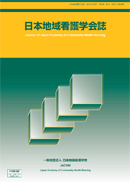Volume 8, Issue 2
Displaying 1-13 of 13 articles from this issue
- |<
- <
- 1
- >
- >|
-
Article type: Article
2006 Volume 8 Issue 2 Pages 5-13
Published: March 24, 2006
Released on J-STAGE: April 20, 2017
Download PDF (1675K) -
Article type: Article
2006 Volume 8 Issue 2 Pages 14-20
Published: March 24, 2006
Released on J-STAGE: April 20, 2017
Download PDF (920K) -
Article type: Article
2006 Volume 8 Issue 2 Pages 21-27
Published: March 24, 2006
Released on J-STAGE: April 20, 2017
Download PDF (1033K) -
Article type: Article
2006 Volume 8 Issue 2 Pages 28-35
Published: March 24, 2006
Released on J-STAGE: April 20, 2017
Download PDF (1607K) -
Article type: Article
2006 Volume 8 Issue 2 Pages 36-42
Published: March 24, 2006
Released on J-STAGE: April 20, 2017
Download PDF (998K) -
Article type: Article
2006 Volume 8 Issue 2 Pages 43-50
Published: March 24, 2006
Released on J-STAGE: April 20, 2017
Download PDF (1057K) -
Article type: Article
2006 Volume 8 Issue 2 Pages 51-57
Published: March 24, 2006
Released on J-STAGE: April 20, 2017
Download PDF (1053K) -
Article type: Article
2006 Volume 8 Issue 2 Pages 58-64
Published: March 24, 2006
Released on J-STAGE: April 20, 2017
Download PDF (950K) -
Article type: Article
2006 Volume 8 Issue 2 Pages 65-72
Published: March 24, 2006
Released on J-STAGE: April 20, 2017
Download PDF (1143K) -
Article type: Article
2006 Volume 8 Issue 2 Pages 73-78
Published: March 24, 2006
Released on J-STAGE: April 20, 2017
Download PDF (846K) -
Article type: Article
2006 Volume 8 Issue 2 Pages 79-86
Published: March 24, 2006
Released on J-STAGE: April 20, 2017
Download PDF (1056K) -
Article type: Article
2006 Volume 8 Issue 2 Pages 87-92
Published: March 24, 2006
Released on J-STAGE: April 20, 2017
Download PDF (821K) -
Article type: Article
2006 Volume 8 Issue 2 Pages 93-98
Published: March 24, 2006
Released on J-STAGE: April 20, 2017
Download PDF (924K)
- |<
- <
- 1
- >
- >|
